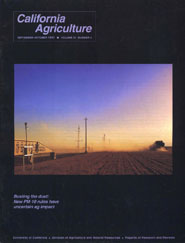All Issues

Busting the dust: New PM-10 rules have uncertain ag impact
Cover:
Research has shown that respirable dust comes from soil. UC Davis scientists are measuring the amount of PM-10 generated by farming activities and analyzing its elemental content. Filtering devices sample air at different heights from the tower at center, and from the array of equipment at left, during wheat harvest near Kettleman City... Photo by Terry James .
September-October 1997
Volume 51, Number 5
Volume 51, Number 5





